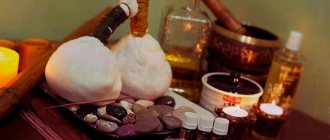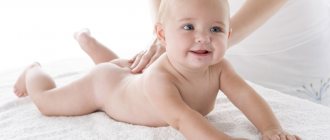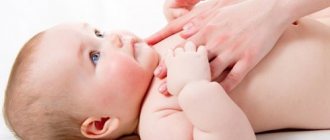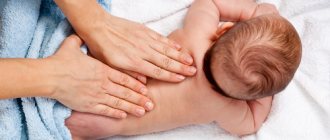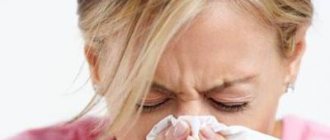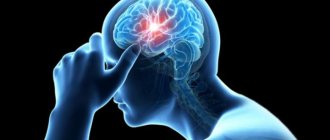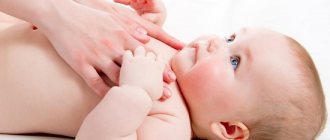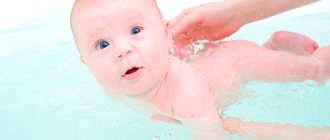Operating principle of drainage massage
During massage movements when coughing, blood supply and lymph flow in the chest area increases. This increases its mobility and also accelerates blood flow. The impact causes mucus in the lungs and bronchi to form faster and to be coughed up more easily.
Massaging a child with a cough is called drainage when the torso is slightly tilted down. In this case, mucus is coughed up better thanks to natural drainage, the role of which is played by the trachea and larynx.
Indications
Cough massage is called drainage massage. Physical impact on the chest improves the removal of mucus from the respiratory tract. This method is good not only for middle-aged children, but also for infants and adult patients. If a child cannot cope with coughing up mucus and it stagnates in the lungs, a massage session is indicated for him.
Drainage massage for children with cough is effective only in the stage of resolution of the disease, when the symptoms of intoxication and dehydration are eliminated. Usually this is 2-3 days for acute bronchitis, 3-4 days for pneumonia.
Airway drainage should not be performed in the following cases:
- Elevated body temperature remains above 38 °C. A massage for a feverish baby will be painful and will not be beneficial.
- If you have a cough, dry drainage massage will be useless. In such cases, cough suppressants are prescribed.
- A child who is weak after an illness should be given several days to recover. Once your appetite and general condition are normalized, you can begin the massage.
Reasons why massage is effective for coughs:
- With the help of massaging movements, the muscles, skin of the back and the front half of the body are warmed up. In the affected areas, blood circulation increases and heat is transferred from the surface of the body deep into the tissues. This leads to the dilution of sputum, which is located on the walls of the bronchi and bronchioles.
- When massaging the child’s pliable and elastic chest, parents seem to knead the lung tissue and bronchial tree, which promotes the discharge of mucus.
- Massage movements are performed from bottom to top, as if pushing mucus out of the respiratory tract. The child's position is horizontal with the head end down and the pelvis raised. Sputum flows under gravity into the main bronchi and trachea, from where the child is able to cough it out.
The measures taken shorten the period of cleansing and restoration of the respiratory tract and prevent relapse of inflammation.
Helpful: I’m rubbing my thighs between my legs, what should I do?
When is the procedure useful?
A cough massage is given to a child in order to strengthen the existing cough reflex. If the child is a newborn, infant or preschool age, his own respiratory system is imperfect. Because of this, the baby cannot fully cough to remove sputum. To strengthen the existing cough reflex, develop the muscles of the chest and warm up the bronchial tree, massage is used. The technique is allowed if a wet cough is caused by:
- ARVI or acute respiratory infections with associated tracheitis;
- pneumonia;
- bronchitis of a viral, bacterial or fungal nature;
- emphysema;
- tuberculosis and cystic fibrosis.
Contraindications for implementation
Massage is contraindicated:
- Immediately after eating. Neglecting this rule causes vomiting in some children.
- For cardiovascular diseases, renal pathologies. The acceleration of blood flow when coughing provokes increased stress on the cardiovascular, respiratory and excretory systems. When they become ill, the child’s condition worsens.
- In the acute stage of the disease, which provokes a severe cough. This stage is accompanied not only by a cough, but also by a rise in body temperature. The massage effect in this case will increase the load on the respiratory and cardiovascular systems, and will also provoke an additional increase in temperature.
- The child has skin diseases. To relieve coughing, the skin is rubbed and pinched, which increases injury to the epidermis and also increases the risk of infection of the rash or ulcers.
Also, before choosing massage as a treatment method, it is worth determining the type of cough. Massaging a dry cough will only make it worse. For dry, medications and techniques are indicated that suppress the reflex, rather than enhance it.
How to do drainage massage for coughs
For a massage procedure, it is not necessary to involve a specialist - one of the parents can perform it. The main thing is to prepare properly, namely cut your nails, wash your hands, remove rings and bracelets.
Preparing the child
Before giving a massage to a child at home, it is necessary to measure his body temperature and wash off dirt and sweat from the skin. The child, wiped dry, is carried or taken into a well-ventilated room.
The room must be maintained at a comfortable temperature - a child with a cough should not be cold without clothes. Before performing the massage, the child is placed on a table or couch with a small cushion placed under the stomach.
Execution technique
The procedure consists of two stages:
- Back massage. First, do 20 strokes from the lower back to the neck. This prepares the skin for the further procedure, and also sets the direction for the outflow of mucus during coughing. In the future, all movements are performed in this direction. After stroking, they begin pinching and tapping. When performing movements, it is important to avoid the kidney area (lower ribs), and also not to pinch the skin above the spine.
- Chest massage. The child is turned over, placing a cushion under the lower back. The chest is first stroked towards the collarbones, and then massaged in a circular motion clockwise and counterclockwise.
Completing the procedure
The warmed skin of the child will turn red from the massage. You can't let him run around the house in this state. The baby needs to be wrapped in a blanket and forced to sit/lie in bed for an hour and a half.
The child’s cough will intensify, so it is not advisable to give the baby food or water within 2 hours after the procedure. Neglecting this measure will cause vomiting, which will irritate your sore throat.
How to properly massage a baby
Drainage massage is allowed for infants from 3 months, but such children have very delicate skin, so you need to be careful with them. Before the massage, be sure to not only wash your hands, but also warm them and lubricate them with baby cream. You cannot use massage oils from “adult” series - they contain fragrances and components harmful to small children.
Babies do not control the process of urination and defecation, so before the procedure the table is covered with oilcloth and a diaper.
After the massage, be sure to wrap the baby in a blanket and put him to bed. Every 15 minutes the child is turned over to the other side so that mucus does not stagnate in the bronchi. You should not place the child on his back, since even a light massage risks provoking increased gag reflexes.
Children under one year old are unable to talk about their discomfort, so you will have to monitor the child’s reaction to the procedure. If the baby cries during a drainage massage, you must stop. If the condition worsens after the massage, parents should contact their pediatrician.
Requirements for massage sessions
It is necessary to follow simple rules so that the procedure gives a positive result and does not worsen the situation.
- Before sessions, consultation with the pediatrician observing the child is required. It is preferable to take a course in massage techniques from a specialist.
- Acupressure should only be performed by a professional, otherwise there is a high risk of pressing on the wrong points, which will lead to undesirable consequences. It is better to avoid honey massage if you are not sure that your child is not allergic to honey. This type of massage is performed according to the same scheme as drainage. It is also better to entrust cupping massage to a specialist, as you can easily damage the baby’s delicate blood vessels.
- The room where the session will be held must be cool - no more than 25 ° C - and sufficiently humidified, at least 65%. This can be achieved by simple ventilation, and in warm weather you can hang wet towels on the radiators.
- The child should be calm and cheerful before the procedure, and the last meal should end at least half an hour before the start of the session. After the massage, wrap your baby in a blanket or blanket. You cannot start running, go for a walk, or go near an open window. Eating immediately after the procedure is also not recommended.
- You can perform up to 6 procedures per day, lasting 2 - 3 minutes, but only the doctor ultimately determines the duration of the session.
- After the massage, ask your child to cough. If the baby is less than a year old, press on the root of the tongue with a clean finger or a spoon. Do not do this very forcefully so as not to induce vomiting.
Other types of massage for coughs in children
In addition to the drainage method of treatment, you can use honey, vibration and acupressure. Each method has its own characteristics and contraindications. The first two methods are available at home; the procedure does not require anyone's help.
Spot
Chinese technique. It is based on the doctrine of points on the human body associated with organs and systems. In China they still believe that influencing certain points normalizes the functioning of the body.
This method will only work if the work is performed by a specialist who understands physiology, manual therapy, and the Chinese method.
In children, the procedure does not cause discomfort that may occur during chest drainage massage.
Vibrating
The technique used to perform a vibration massage for cough differs from a drainage massage. The back in the chest area is not massaged, but tapped. The vibrations from these taps improve the discharge of sputum. You cannot knock on your bare back - you must place one hand on top of the body and lightly hit it with the other.
This way, vibration is transmitted to the baby’s body, but the risk of accidental injury is eliminated. The spine area should not be tapped even through the hand.
Honey
To perform this massage, the back is covered with liquid honey. Then, pressing your palm against the baby’s sticky back, they sharply tear it away from the skin. Gradually, the separation will become more difficult.
The effect warms up the skin and muscles in the chest area, cleansing the subcutaneous tissues of toxins and accumulated decay products.
Contraindications to honey massage are age under one year, allergy to honey, diabetes mellitus.
Carrying out the procedure at different ages
| Child's age | Features of massage | Duration and frequency of sessions | Notes |
| Up to 1 year | It is advisable to use baby oil for massage to make it as gentle as possible. They mainly use stroking, light rubbing of the back and tapping with fingertips on the back of the hand lying on the child’s back. The spine area should not be touched. It is better to entrust baby massage to a professional massage therapist. | 3–5 minutes, no more than 1 session per day. | Therapeutic massage is usually not prescribed for children under 3 months of age. Honey, acupressure and cupping massages are also not prescribed until one year of age: children are very vulnerable at such an early age. |
| From 1 to 3 years | During this period, you can already massage yourself. During a vibration massage, you can tap your fingers directly on the baby’s back, and not on your hand. The massage also includes stroking, rubbing and kneading. You can gently massage your baby's chest, without effort or pressure. | 5–8 minutes, 2 sessions per day. | You can add a honey massage to the vibration massage if the child is not allergic. The use of oil is optional. |
| From 3 to 7 years | You can start combining or alternating vibration massage with drainage massage. From the age of three it is possible to use cupping massage. | 10–20 minutes, 2–3 sessions per day. | Before using cupping massage, the surface of the back must be lubricated with warm oil. For other types of massage, you can do without it. |
| After 7 years | Any type of medical massage prescribed for cough is applicable. | 20–30 minutes, 2–3 sessions per day. | When performing the procedure, normal massage intensity is applicable, although with more caution than for adults. |
